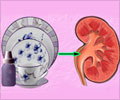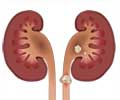Researchers suggest that the risk of women developing the disorder and the number of cases being reported to emergency departments in the US has risen in recent years.

"While the number of patients visiting the emergency department had increased over that time period, it was women who had the greatest increase in visits," says Khurshid R. Ghani, M.D., of Henry Ford's Vattikuti Urology Institute and lead author of the study.
The study is published online in the Journal of Urology.
Citing recent population-based studies that have shown an increase in kidney stones among women, Dr. Ghani says his team's findings in the ER provide further evidence that the risk of stones in women appears to be increasing.
"Women are becoming more and more obese. Obesity is a major risk factor for developing a kidney stone. And one fascinating thing about women versus men is obese women are more likely to develop a stone than an obese man," says Dr. Ghani.
Drawing raw data from the Nationwide Emergency Department Sample (NEDS), the research team looked for related emergency room visits from 2006 – 2009. They found a total of more than 3.6 million visits for upper urinary tract stones.
Advertisement
"I think in the last 10 years, the way urologists manage kidney stone patients in the ER has changed dramatically," says Dr. Ghani. "Today, the emergency room physician and urologist have access to better diagnostic tools that allow for a more precise diagnosis. We use a CT scan, which is a quick test that allows for an immediate diagnosis and is available in every emergency department.
Advertisement
Also, medication can help with the spontaneous passage of these stones. As a result, some of these patients may be safely managed through the outpatient system with follow-up visits."
For those who do get admitted to the hospital, the study showed that the highest likelihood was related to sepsis, or blood infection, which can sometimes occur when the stone causes a blockage and urinary tract infection.
Most notably, in 2009, the charges for emergency department visits rose to $5 billion in 2009 from $3.8 billion dollars in 2006.
"One of the possible reasons for the increase in charges is the use of a CT scan to diagnose a kidney stone," Dr. Ghani says.
"Fifteen years ago, around 5-10 percent of patients visiting the emergency department for a kidney stone would get a CT scan. Today, 70 percent of patients who visit the emergency department get a scan. While they're wonderful tools of technology that allow an accurate diagnosis, they are expensive," says Dr. Ghani.
Source-Eurekalert















